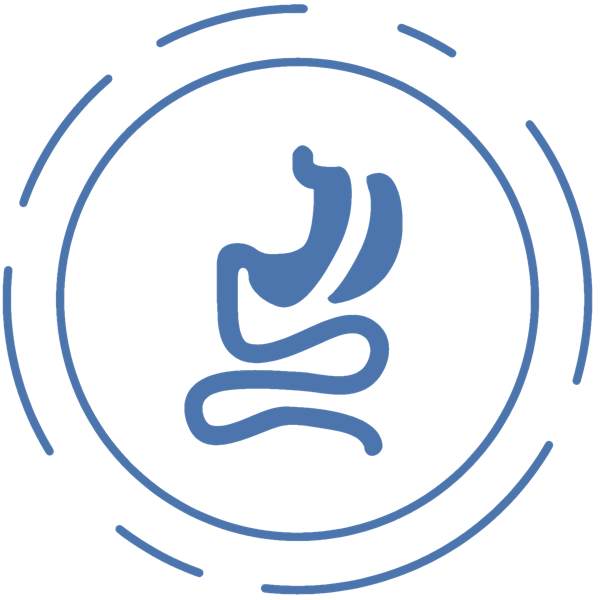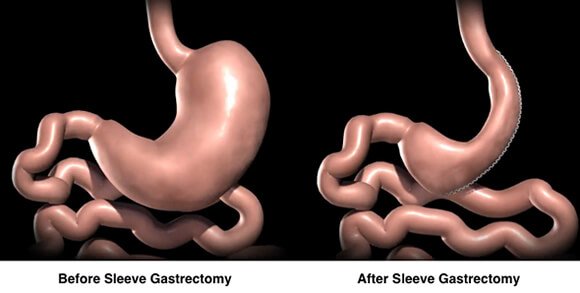
Sleeve gastrectomy, also referred to as vertical sleeve, gastric sleeve or tube gastrectomy, is a surgical procedure performed for the treatment of obesity. The procedure is a restrictive bariatric surgery to treat extremely obese patients with a high BMI of 30-35 and above. It encourages weight loss by restricting the stomach size so it holds only a limited amount of food. This helps patients to eat less without hampering the normal digestive process.
Sometimes sleeve gastrectomy is carried out as a first stage of a 2-stage operation in extremely obese patients with a BMI of 60 or more. This is done to achieve a considerable amount of weight loss so it is safer for the patient to undergo a second bariatric surgery if needed.


The procedure is performed under general anaesthesia. Small keyhole incisions are made on your abdomen. A laparoscope, a thin instrument with a light and camera attached, is inserted through one incision, allowing the surgeon to clearly view the internal organs on a monitor.
Additional surgical instruments are inserted through the other incisions. The surgeon will remove nearly 75-80% of the stomach. A thin sleeve shaped like a banana is created by stapling the remaining part of the stomach. At the end of the procedure, the incisions are closed with sutures. The entire procedure takes about 60 to 90 minutes to complete.
The operation also alters some of the hormone signals from the stomach and intestine to parts of the brain that control body weight: many patients report that following this operation they feel less like eating and feel fuller sooner and for longer after a meal.
Advantages and disadvantages of sleeve gastrectomy
Advantages:
- Reduced stomach size makes you feel full sooner
- Normal functions of the stomach are retained
- Can be performed laparoscopically
- Shorter hospitalisation stay 2-3 days
- No implant used as in lap band surgery
- Minimal post-operative pain and discomfort
- Shorter recovery time
Disadvantages:
- Irreversible
- Need for second surgery in highly obese patients
Post-operative care:
- Your doctor will prescribe pain relieving medications to keep you comfortable following the procedure.
- You will be advised to take medication to reduce the amount of acid produced by your stomach.
- Avoid strenuous exercises and lifting heavy weights until approved by your surgeon
- For the first month after the procedure, eat only small amounts of soft foods
- Sip water throughout the day to prevent dehydration.
- Eat highly nutritious diet rich in proteins with a low fat content.
- Your dietitian will tailor a new diet regimen for you to follow.
Risks and complications:
As with any surgery there are potential risks and complications involved. The risks include blood loss, infections, problems associated with anaesthesia, and deep vein thrombosis (blood clot in the leg).
The major complication following sleeve gastrectomy surgery is occasional leakage or breakdown of the gastric contents from the staple line that secures the divided stomach. This may result in requiring further surgery ; endoscopic procedures – including balloon dilatations; stents and a prolonged admission in hospital.
How much weight can you expect to lose?
You can expect to lose between 55% and 85% of your excess weight in the first 12–18 months following surgery: However an excess weight loss of 100% or more is not uncommon in patients who do intensive exercising.
The amount of weight you are able to lose and keep off after surgery will depend also on the lifestyle changes that you make, such as increasing the amount of exercise you take and eating a healthy diet. It is important to remember that the operation will not stop from you from craving certain foods or eating what you fancy.
What are the risks of a Sleeve gastrectomy?
As with all major surgery sleeve gastrectomy has some risks. These risks vary according to your age and other illnesses you may have.
The risk of death within the first 30 days after surgery is estimated to occur in less than 0.5% (or 1 in every 200 patients) having this operation. This number does not reflect the experience of Dr. Ahmed but it is calculated on national and international averages on the base of large multicentre databases.
Other complications, listed below, happen in less than 5% of patients (or 1 of every 20 patients).
• Dismotility: very occasionally the new stomach may respond to surgery with frequent spasms and a temporary intolerance to food and even liquids. This is a rare and unpredictable event which may require temporary tube feeding.
Long term complications after Sleeve gastrectomy surgery
Long term problems are uncommon but can include:
- Port site hernias of the abdominal wall
- Narrowing (stricture) of the sleeve which can make eating and drinking more difficult. This will need to be stretched with an endoscopy
- Hair loss or thinning in the first six months. This is a temporary side effect of the rapid weight loss and it will re-grow
- Gallstones
How should you prepare for the procedure?
- Discuss the operation with your close friends and family.
- Meet other patients
- Make healthier changes to your lifestyle
- Two weeks before the operation you will be required to follow a low calorie liquid diet. This will help shrink the liver and make the operation easier for the surgeon and safer for you.
The day of the operation
You will usually be admitted to the hospital on the day of your operation. You must not have anything to eat or drink (this includes chewing gum and calorie free mints) from 8 hours before your surgery, although you may drink plain water up until 2 hours before. You will then go to theatres where the anaesthetist puts you to sleep. You will also be given an intravenous drip so you can have fluids during the operation.
What should you expect after the procedure?
The day after the operation
If you have been looked after in Intensive Care you will be transferred to the ward.
The amount you may drink will be increased every couple of hours until you are able to take at least one glass of water every hour. Your drip will be removed when you are drinking enough to keep you hydrated.
The following one-two days after the operation
You should start to feel better very quickly after the operation and will be able to move around on your own.
You need to drink one 125ml glass of smooth fluid every hour when you are awake. For example you may have tea and coffee, milky drinks and soup with no lumps.
Two to three days after surgery you will be able to go home.
At discharge
Pain and medication
Sleeve gastrectomy is usually not a painful procedure. You will be given a supply of soluble painkillers to take home with you; these should be taken regularly for the first few days. If you have no pain gradually reduce the number of tablets you are taking. Allow soluble tablets to stop fizzing before you drink them. You will also prescribed an anti-acid sublingual tablet (lansoprazole fastab) to be taken daily for at least three months after your surgery.
If you have been taking medication to control your blood pressure or diabetes, these will be reviewed before your discharge. In most cases these can be reduced or sometimes stopped all together. Please make sure you are clear about this before you leave the hospital.
Please note: Do not take any large tablets for first two weeks as they may get stuck and damage the staple line. All tablets have to be crushed or taken in soluble form. If in doubt please ask your surgeon
Wounds
The small incisions made for your surgery will be more or less healed by the time you leave hospital. The steri-strips (paper stitches) should be left to come off by themselves. Any stitches will be soluble. You will only need to go home with dressings if one of the wounds is oozing. If this is the case the ward nurse will ask you to visit the nurse at your GP surgery. If any concerns, please remember that you can always refer to your surgeon
Anti-embolic stockings
You should take these home with you and continue to wear them until you are walking about on a regular basis. If you flying within six weeks from surgery, you should wear them during the flight.
Eating and Drinking
You will be given a diet information sheet. You should have this with you at all times so you know what to drink and are familiar with the stages of food introduction in the next few weeks. In case of doubt you are advised to contact your dietitian.
Washing
You can have a shower but do not soak in the bath for at least a week after surgery.
Driving
You may drive as soon as you can comfortably wear a seat belt and are able to perform an emergency stop (independently assessed by a close relative or a friend). You should check with your insurance company for their specific advice about driving after keyhole (laparoscopic) surgery.
Other Activities
You will be able to walk straight after surgery. Try to go for a walk every day, gradually increasing the distance as you feel able. You will probably need at least 2 weeks off work but please check with your surgeon. It is advisable to avoid heavy lifting for at least 1 month after abdominal surgery, if you are unsure discuss with your surgeon. You may resume sexual activity as soon as you feel comfortable.
Women of childbearing age must not become pregnant for at least one year following sleeve gastrectomy surgery. After one year: if you are planning a pregnancy please contact your dietitian for nutritional advice.







